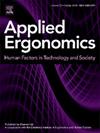Gait variability predicts post-fatigue obstacle course performance among military cadets: An exploratory study
IF 3.1
2区 工程技术
Q2 ENGINEERING, INDUSTRIAL
引用次数: 0
Abstract
We explored the extent to which pre-fatigue gait variability during load carriage is associated with the ability of an individual to perform an obstacle course post-fatigue. Twenty-four military cadets were monitored during treadmill gait and completed an obstacle course before and after a full-body fatigue protocol. Gait variability measures were determined from spatiotemporal stride characteristics, joint angle trajectories, and inter-joint coordination. These measures were then used in multiple linear regression models to predict three measures of post-fatigue performance (i.e., hurdle completion time, maximum jump height, and maximum jump distance). Measures of joint kinematic variability predicted 73–89% of the variance in post-fatigue performance. Specifically, the significant predictors were sagittal plane variability of 1) hip angle and hip-knee coordination during swing phase; and 2) knee-ankle coordination during both stance and swing phase. Measures of joint kinematic variability obtained from gait thus appear relevant for predicting individual differences in adapting to fatigue, and such measures could aid in predicting post-fatigue performance in diverse dynamic tasks.
步态变异性预测疲劳后障碍训练学员的表现:一项探索性研究
我们探讨了疲劳前的步态变化在多大程度上与疲劳后个体进行障碍训练的能力有关。24名军校学员在跑步机的步态和完成障碍训练前后进行了全身疲劳训练。步态变异性测量由时空跨步特征、关节角度轨迹和关节间协调确定。然后将这些指标应用于多元线性回归模型中,预测疲劳后的三项指标(即跨栏完成时间、最大跳跃高度和最大跳跃距离)。关节运动变异性的测量预测73-89%的疲劳后性能方差。具体来说,有意义的预测因素是:1)髋关节角度和髋关节-膝关节协调在摆动阶段的矢状面变异性;2)站姿和挥拍阶段的膝踝协调。因此,从步态中获得的关节运动变异性的测量似乎与预测个体适应疲劳的差异有关,并且这些测量可以帮助预测不同动态任务中的疲劳后表现。
本文章由计算机程序翻译,如有差异,请以英文原文为准。
求助全文
约1分钟内获得全文
求助全文
来源期刊

Applied Ergonomics
工程技术-工程:工业
CiteScore
7.50
自引率
9.40%
发文量
248
审稿时长
53 days
期刊介绍:
Applied Ergonomics is aimed at ergonomists and all those interested in applying ergonomics/human factors in the design, planning and management of technical and social systems at work or leisure. Readership is truly international with subscribers in over 50 countries. Professionals for whom Applied Ergonomics is of interest include: ergonomists, designers, industrial engineers, health and safety specialists, systems engineers, design engineers, organizational psychologists, occupational health specialists and human-computer interaction specialists.
 求助内容:
求助内容: 应助结果提醒方式:
应助结果提醒方式:


